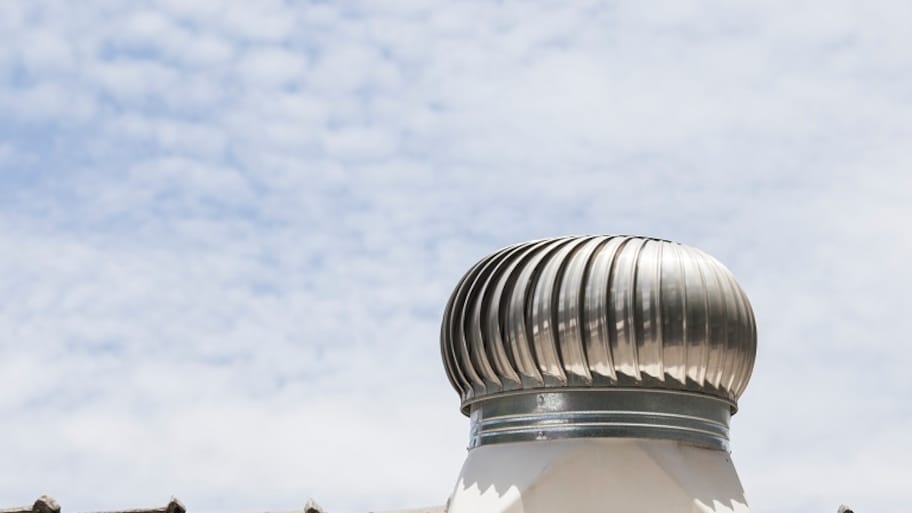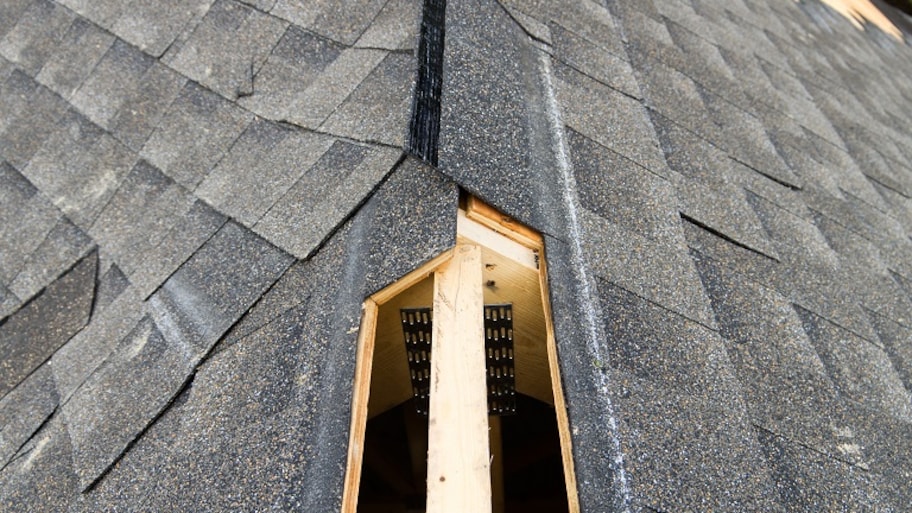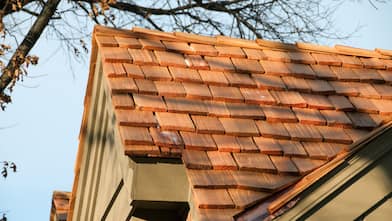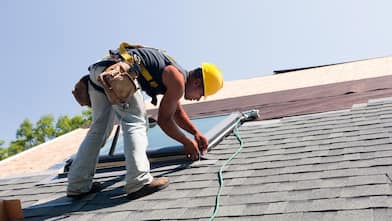The average ridge vent installation cost is between $300 and $650, including materials and labor
The standard ridge vent price is typically $2 to $3 per linear foot, with the labor to install it costing between $45 and $75 per hour. Your final costs will vary based on the size, type, and number of units you install.
What does a roof ridge vent do? Moisture is a sneaky yet lethal menace when it comes to your roof. Condensation is a common winter roofing issue, as well as during other times of the year, so it’s important to have adequate ventilation to get rid of all that moist air. Ridge vents offer ventilation throughout the length of your roof’s peak, giving moist air plenty of room to escape so your roof—and everything beneath it—stays dry.
How Much Does Ridge Vent Installation Cost per Foot?
The average ridge vent price is about $2 to $3 per linear foot. This doesn’t include installation, which will run you an additional $45 to $75 per hour. Homeowners usually pay a total of around $300 to $400 in labor costs.
You should install soffit vents, which cost between $3.30 and $4.50 per linear foot. These maximize the efficiency of your roof ridge vents by allowing fresh outside air to enter.
Many roofing pros swear by the need to have these types of intake vents.
“In fact, if you do not have intake vents, such as soffit vents, the ridge vents won't do any good because they need to be able to pull the air from somewhere,” says Ami Feller, Expert Review Board member and owner of Roofer Chicks in New Braunfels, TX. “Basically, when you ventilate an attic, you are creating an air current that cycles through the attic space, bringing in air from the low point and letting the air escape through the high point.
How Much Does It Cost to Install a Ridge Vent Yourself?
First and foremost: let’s not forget Clark Griswold. Working on a roof is extremely dangerous, and you shouldn’t consider it unless you really, really know what you’re doing.
It’s also worth noting that this is an advanced-level DIY with a high risk of error. Hiring a roofing contractor near you will prevent the need for any costly repairs, leaks, or other damage caused by improper installation.
DIY Ridge Vent Installation Cost Breakdown
For scrappy DIY-ers who still want to tackle this project on their own, there are some key costs to consider. Hopefully, you already have a ladder that can safely reach your roof, because a new one could cost $250 to $350 or more. Considering your average cost to install the ridge vent professionally is around $300 to $650, according to HomeAdvisor, it will likely make the most sense to call a pro if you don’t have a ladder handy.
Your ridge vent price usually goes by four-foot sections for around $8 to $12 each. For metal roofs, straps and connector plugs to adjoin the sections will go for about $5 to $6 apiece.
Here are the other supplies you’ll need, along with some ballpark cost estimates:
Roofing nails: $10–$15 (five-pound bag)
Roofing screws with neoprene washers to create a seal: $30 (200–300 screws)
Polyurethane caulk: $8
Hammer: $7
Cat’s paw pry or utility bar: $6
Utility knife (hook blade): $15
Chalk line: $8
Circular Saw: $150
Fall Protection Kit: $120
Total Cost: $354
You’ll also need to factor in new roofing shingles where you put in the ridge roof vent. These are usually around $30 for 33.3 square feet, but your final cost will vary depending on the type and how much you need.
Ridge Vent Installation Cost Breakdown
Here’s a basic breakdown of your cost to install a ridge vent:
| Ridge Vent Price | Professional Installation | Average Project Total |
|---|---|---|
| $2 – $3 per foot | $45 – $75 per hour | $300 – $650 |
Ideally, you’ll also roof’s eaves. These provide even more ventilation by allowing fresh air to enter from outdoors. Basic soffit vents go for an average of $3.30 to $4.50 per linear foot, along with the cost for the additional labor.
How Much Does It Cost to Install a Roof Vent by Type?
If you’re considering roof vent costs, you’ve got a few good options available. Ridge vents typically rank at the top of the cost pyramid, but they’ve got a lot of good qualities to show for it. Below are the most common types of roof vents and what they could cost.
Ridge Vent Installation Cost
The average roof ridge vent installation cost is $300 to $650, including labor and materials. While it's a pricier option, you’re treating yourself to the most effective non-powered roof ventilation system. They also blend in with your roof for a much sleeker look than other vents.
Cost to Install a Roof Vent
A roof vent will cost around $500 per unit. Also known as a “box vent” or “low profile vent,” this type of vent costs less than other styles, plus it won’t require new shingles when you install it. It’s also simple to add to an existing roof. However, there’s only one point of entry for airflow and they have a “boxy” appearance that many homeowners don’t favor.
“Also, the more holes you cut in your roof, the more chance you have of having a leak,” says Feller. “Because box vents only allow 1 square foot of outtake ventilation, it generally takes several of them to provide enough ventilation.”
Side note: it’s essential to inspect your roof every six months if you choose to install these, as they’re especially prone to debris and can also harbor small critters.
Cost to Install Soffit Vents
Soffit ventilation units cost between $2 and $10 per linear foot, plus $45 to $75 per hour for labor. The average cost to install soffit units is about $315 to $465. These are essential to improve the efficiency of ridge, roof, and gable vents. Plus, because they’re placed on the bottom of the roof’s eaves, they have a very subtle look.
Gable Roof Ventilation Price
Gable ventilation units are the least expensive option at about $60 to $150 per unit, plus about $70 per hour in labor costs. These are nice to look at and can mount right to your attic fan. However, as with a roof vent, there is only one exit and entry point for airflow.
“We use a lot of electric power vents,” says Feller. “They also make solar ones. These vents are mounted to the roof and have a thermostat on them. When the attic reaches the prescribed temperature—we set ours at 100 Fahrenheit—they will kick on and start moving air out of the attic space.”
Note: If you’re installing a ridge vent with an existing gable, it’s best to seal the gable. This is because gables can disrupt the airflow, doing more harm to your attic than good.
Roof Turbine Installation Cost
A roof turbine installation will cost around $65 to $250, which includes labor and materials. The units themselves are usually $20 to $100 each. These contain a fan that works by catching wind which turns the fan and brings air up from the attic, dispersing it outdoors.
Note that wind turbines can get damaged easily by falling debris or rodents, and may start to “creak" with old age. Sometimes, older units can emit a high-pitched noise. Also, like with box vents, you may need several of them to properly ventilate an attic space—which means more potential leak points.
What Factors Influence the Cost to Install a Roof Vent?

Your roof vent installation cost can vary considerably based on a few factors. The final cost of your project depends on:
The type of roof vent
The surface area of your roof
Labor costs in your area
The number of units (where applicable)
FAQs
What is better: a ridge vent or roof vent?
Ridge vents run the length of your roof instead of just offering ventilation at a single point (like a roof vent or gable vent). This makes them the superior option, hands down. Also: unless you’re Snow White, you probably don’t want any squirrels or other small animals in your home. These critters can sometimes come in through your box vents, and they’re not even going to help you wash the dishes.
This is not to say that roof vents are a bad choice. If you have a limited budget, they offer great roof ventilation for the price. They’re also easier to install on an existing roof. In any case, some airflow is vastly better than none.
In the end, it mostly depends on the shape of your roof. For hip roofs, many pros recommend an electric or solar power vent. A professional roofer can guide you to the right choice.
How do you calculate how much venting you need?
You should figure at least one square foot of ventilation per 150 square feet of attic space.
Do ridge vents leak?
Anytime you have a hole in your roof, you’re likely going to see a little water come through depending on how much rainfall there is. This generally isn't enough water to do any damage, but if you go stand in your attic during a storm, you might experience a drop or two, which is normal. Ridge vents shouldn’t leak significantly if they are installed properly. Mistakes such as using the wrong nails or not overlapping sections correctly might lead to leakage issues.
What happens if I don’t ventilate my roof?
Roof vents are a roofing essential, as they promote energy efficiency by keeping warm, humid air at bay. The roofing material, especially asphalt shingles, will not last as long as it should (about half of its manufacture life) if the attic is not ventilated. Also, going without ventilation means having a warm attic that demands more from your air conditioning system (and your wallet once the bills come). Ridge vents and roof vents also prevent a host of other icky moisture-related problems like rot, mold, and mildew.





